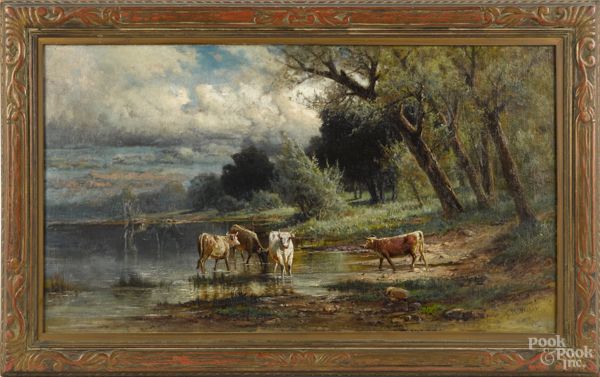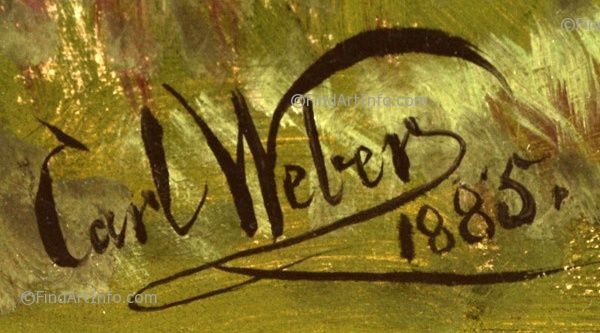Table of Contents
In the realm of American art, one name stands out for its enduring influence and captivating depictions of rural landscapes – Carl Weber (1850–1921). Born in Philadelphia to the esteemed German immigrant and landscape painter Gottlieb Daniel Paul Weber (1823–1916), Carl Weber’s artistic journey traverses continents and epochs, leaving an indelible mark on the canvas of American landscape painting.

Early Adventures in Europe: Munich Royal Academy and Paris Sojourn
Carl Weber’s artistic odyssey began with a pilgrimage to the Munich Royal Academy of Fine Art, where he studied under the tutelage of the distinguished landscapist Karl Raupp (1837–1918). To further refine his craft, Weber sought private lessons from two eminent professors at the Städelsche Kunstinstitut in Frankfurt – Jakob Becker (1810–1872), a master of genre and landscape painting, and Johann Eduard von Steinle (1810–1886), a luminary in historical painting.
Despite not being formally registered at the Städelsche Kunstinstitut, Weber’s dedication to honing his skills through private lessons marked the beginning of his artistic prowess. Following his European sojourn, he spent a transformative year in the artistic hub of Paris, absorbing the rich cultural milieu and incorporating diverse influences into his burgeoning artistic palette.
The Return to Philadelphia: Crafting a Distinctive Artistic Voice
Returning to Philadelphia in the mid-1870s, Carl Weber embarked on a creative journey that would distinguish him as a successful landscape painter. His marriage to Clara Kaiser, daughter of the renowned interior decorator Otto Ferdinand Maximillian Constantine von Kaiser, added another layer of artistic refinement to his life.
Collaborating with his cousin, the musician Carl Philip Weber, Carl shared a studio where artistic endeavors blended seamlessly. His intermittent exhibitions at the Pennsylvania Academy of the Fine Arts and the Philadelphia Art Club, spanning from 1876 to 1908, showcased the evolution of his distinctive style. Additionally, he exhibited at the prestigious National Academy of Design from 1881 to 1893, further solidifying his presence in the American art scene.
Recognition and Legacy: Awards and Influence
A testament to Carl Weber’s artistic prowess is the recognition bestowed upon him by esteemed organizations. Membership in the Philadelphia Artists’ Fund Society and the American Art Association, where he received a Gold Medal in 1902, underscored his standing in the art community.
Weber’s studio at 816 Chestnut Street became a hub of creativity and innovation, resonating with the spirit of Earle’s Gallery, where many Philadelphia artists showcased their work. Honorable mentions at the World’s Columbian Exposition in Chicago (1893) and the Atlanta Exposition (1895) added accolades to his illustrious career.
Weber’s Artistic Palette: A Fusion of Styles
Carl Weber’s mature work bears the imprint of the French Barbizon style, a nod to his European influences. Yet, beneath the layers of international inspiration, he retained the essence of his German academic training. The fusion of styles is evident in the vibrant landscapes that echo the plein air traditions of German painters like Eduard Schleich the Elder (1812–1874) and Adolph-Heinrich Lier (1826–1882).
An Exploration of Landscape: Weber’s Artistic Contributions
Weber’s artistic journey took him beyond the boundaries of Pennsylvania, with his brush capturing the bucolic charm of rural landscapes. Scenes from Johnstown, New Jersey, New England, and Illinois found their place on his canvases, each painting a testament to the versatility and depth of his artistic contributions.
Legacy and Beyond: A Lasting Influence
Weber’s legacy extends far beyond the realms of his artistic contemporaries. His influence transcends time, weaving into the fabric of American art history. As a luminary in the landscape genre, Weber’s impact reverberates in the contemporary art scene, resonating with art collectors, enthusiasts, and institutions alike.
Carl Weber’s artistic journey is a captivating narrative of cross-cultural influences, artistic evolution, and lasting legacy. His landscapes, infused with the spirit of both Europe and America, continue to captivate art connoisseurs and enthusiasts, solidifying his place in the pantheon of American landscape painters.
FAQs
Where did Carl Weber study art?
Carl Weber studied at the Munich Royal Academy of Fine Art and took private lessons from professors at the Städelsche Kunstinstitut in Frankfurt.
What awards did Carl Weber receive?
Carl Weber received a Gold Medal from the American Art Association in 1902 and honorable mentions at the World’s Columbian Exposition in Chicago (1893) and the Atlanta Exposition (1895).
What influenced Carl Weber’s artistic style?
Carl Weber’s mature work reflects the influence of the French Barbizon style and retains elements of his German academic training.


Very interesting subject, thank you for putting up.Money from blog